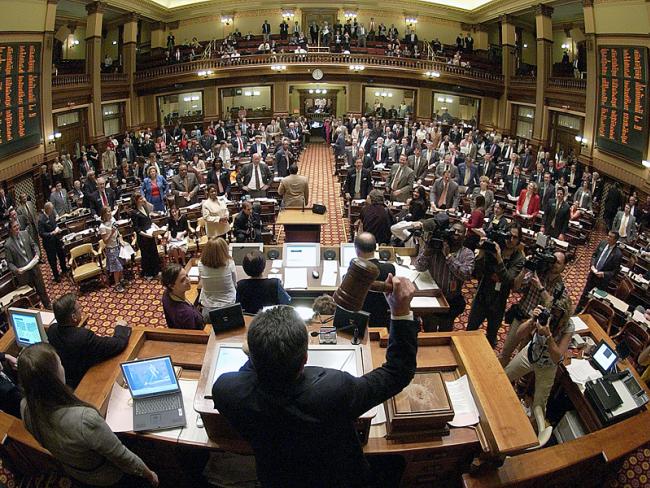This coming Tuesday marks Super Tuesday, the busiest election day of the Republican presidential primary season with nine states voting and a tenth (Alaska) beginning its 18-day caucus period. With 410 delegates – nearly 18% of the total convention delegates – at stake, Tuesday may represent former Massachusetts Gov. Mitt Romney’s last chance to sew up his party’s nomination decisively in advance of the Republican National Convention in August, as well as the possible last stands for his self-styled movement conservative opponents, former House Speaker Newt Gingrich and former Sen. Rick Santorum of Pennsylvania. But this Super Tuesday may prove considerably less “super,” or at least less momentous, than others in modern electoral memory.
In 2008, a record-setting 24 states held presidential nomination contests on February 5, dubbed Super Duper Tuesday at the time for its sheer scale. On the Republican side, Super Duper Tuesday more or less ended the race in Arizona Sen. John McCain’s favor, confirming a result expected since McCain’s hard-fought January victories in New Hampshire, South Carolina and Florida. Yet the historic geographical reach of Super Duper Tuesday did little to resolve a contentious Democratic race between Senators Hillary Clinton of New York and Barack Obama of Illinois, with the latter notching victories in caucus states of the Midwest and Mountain West as well as in the heavily African-American Deep South while Clinton led in the greater Boston-New York region, the “border South” from Oklahoma to the Appalachians and California.
The GOP map for Tuesday could as easily presage a Romney sweep as a reignited three-way brawl heading into further showdowns through the spring (though “third wheel” candidates like Gingrich have historically flamed out post-Super Tuesday). Romney should do well in his adopted home state of Massachusetts as well as in neighboring Vermont and Virginia, where he and libertarian firebrand Rep. Ron Paul of Texas were the only candidates to file successfully. Santorum hopes for momentum-restoring wins in Ohio, Oklahoma and Tennessee after a disappointing (if respectably narrow) loss in Michigan. Gingrich has set expectations a bit lower, claiming only that he hopes to win Georgia by a larger margin than Romney won his native Michigan. At the moment Romney appears competitive in nearly all states that have been polled, and a Romney victory in Ohio or (to get a bit ambitious) a Southern state like Tennessee might go a long way toward reassuring the party rank-and-file that he can win the loyalty of conservatives outside the nation’s coasts and the “Mormon Belt” of the West.
Michigan as prologue
After a three-state drubbing at the hands of Santorum on February 7 and a controversial victory over Paul in Maine, Romney slowly and steadily returned to clear frontrunner status at the end of the month amid a narrow 41% to 38% triumph over Santorum in Michigan and an easy 20-point win in Arizona. Yet even in Michigan, Romney’s edge was confined largely to the same demographics who have supported him all along: older voters with college educations and disposable incomes. Romney is fortunate that these sorts of voters are overrepresented in Republican nominating electorates relative to the general population, but after his demonstrated across-the-spectrum advantages in Florida, it might surprise a news media eager to reframe a tired narrative that Santorum remained the favorite among those two-thirds of primary voters earning less than $100,000 (by a 41% to 37% spread) and especially for conservatives (by a more convincing 50% to 36%). Romney has worked concertedly to win over self-described conservatives in the past several months, going so far as to call himself “severely conservative,” but even in Michigan, failed to close that sale.
Yet Romney’s advantages over Santorum, Gingrich, and Paul are hard to overstate. Where Santorum and Gingrich rely greatly on Super PAC donations from multimillionaires, Romney remains the only GOP candidate able to invest his own resources and burn through large sums of cash without concern that major donors will abandon his campaign. He has lucked out from winner-take-all delegate rules in some of his strongest states, including Florida, Arizona and (still upcoming) New York and California. Perhaps more importantly, the party establishment still mortally fears potential Gingrich or Santorum general election candidacies, less because of those contenders’ poor fundraising than because of their rigid social-conservative rhetoric and polarizing public images.
A long road ahead
If Romney can win Ohio, and erode Santorum’s natural advantages with comparatively blue-collar and conservative primary voters, he may begin to seem unstoppable. Ohio’s Republican electorate should be similar to Michigan’s, though perhaps a tad more conservative. Romney can expect good margins in the upscale suburbs of Cleveland, Cincinnati, and Columbus, but may struggle in the Appalachia-tinged eastern region of the Buckeye State. A Santorum win in Ohio would revive past narratives of conservative discontent with Romney’s candidacy and make Michigan seem a home state fluke; and the South remains decidedly hostile territory for the putative frontrunner. It is increasingly difficult at this juncture – in the wake of false starts for movement-favored candidates in Iowa, South Carolina and on February 7 – to imagine a lasting and ultimately successful insurgency against Romney.
Yet a nomination-clinching 1,144 convention delegates will not even be allocated until April 24, and Romney has failed at critical moments to extinguish said insurgency. Should self-described conservatives begin to vote for Romney outside his most favorable geographical regions of New England and the Mountain West, he will have taken a vital leap toward earning his party’s endorsement. In the meantime, pundits and political junkies alike continue to search for signs that the pervasive dissatisfaction surrounding Romney has eased at last.


